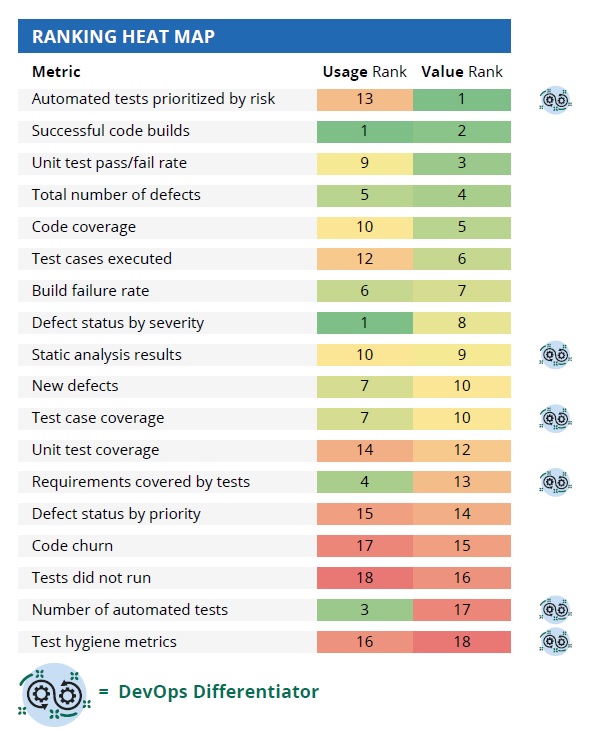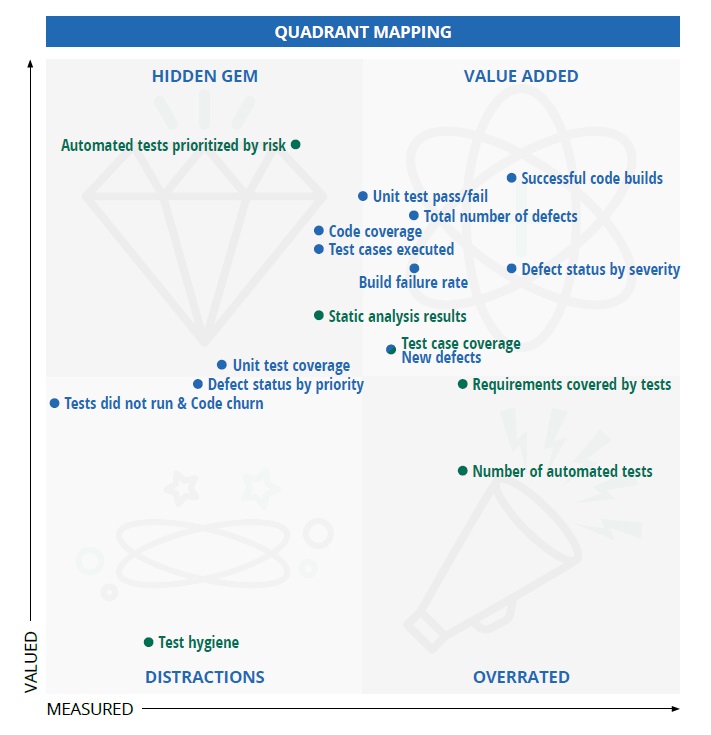Backslash Security(link is external) announced significant adoption of the Backslash App Graph, the industry’s first dynamic digital twin for application code.
The way that we develop and deliver software has changed dramatically in the past 5 years — but the metrics we use to measure quality remain largely the same. Despite seismic shifts in business expectations, development methodologies, system architectures, and team structures, most organizations still rely on quality metrics that were designed for a much different era.
Every other aspect of application delivery has been scrutinized and optimized as we transform our processes for DevOps. Why not put quality metrics under the microscope as well?
Are metrics like number of automated tests, test case coverage, and pass/fail rate important in the context of DevOps, where the goal is immediate insight into whether a given release candidate has an acceptable level of risk? What other metrics can help us ensure that the steady stream of updates don’t undermine the very user experience that we’re working so hard to enhance?
To provide the DevOps community an objective perspective on what quality metrics are most critical for DevOps success, Tricentis commissioned Forrester to research the topic. The results are published in a new ebook, Forrester Research on DevOps Quality Metrics that Matter: 75 Common Metrics—Ranked by Industry Experts(link is external).
The goal was to analyze how DevOps leaders measured and valued 75 quality metrics (selected by Forrester), then identify which metrics matter most for DevOps success. Here’s a look at the process:
1. Survey 603 global enterprise leaders responsible for their firms’ DevOps strategies.
2. From that sample, identify the firms with mature and successful DevOps adoptions (157 met Forrester’s criteria for this distinction).
3. Learn what quality metrics those experts actually measure, and how valuable they rate each metric that they regularly measure.
4. Use those findings to rate and rank each metric’s usage (how often experts use the metric) and value (how highly experts value the metric).
5. Compare the DevOps experts’ quality metric usage vs that of DevOps laggards. If there was a significant discrepancy, the metric is considered a DevOps differentiator.
The 75 DevOps quality metrics were divided into 4 categories:
■ Build
■ Functional validation
■ Integration testing
■ End-to-end regression testing
For each category of quality metrics, we came up with a heat map showing usage vs. value rankings. For example, here is the heat map for the Build category metrics.

We also plotted the data for each metric into a quadrant with 4 sections:
■ Value added: Metrics that are used frequently by DevOps experts and consistently rated as valuable by the organizations who measure them.
■ Hidden gem: Metrics that are not used frequently by DevOps experts, but are consistently rated as valuable by the organizations who measure them.
■ Overrated: Metrics that are used frequently by DevOps experts, but not rated as valuable by the organizations who measure them.
■ Distraction: Metrics that are not used frequently by DevOps experts, and not rated as valuable by the organizations who measure them.
For example, here is the quadrant for Build category metrics:

The ebook(link is external) provides both heat maps and quadrants for all 4 categories, a quick look at each of the 75 metrics, per-category and overall analyses, and a few fun lists. Here’s a preview…
Hidden Gems
The following metrics are not commonly used (even among DevOps experts), but are ranked as extremely valuable by the select teams who actually measure them:
1. New defects (IT)
2. Critical defects (FV)
3. Automated tests prioritized by risk (Build)
4. Code coverage (Build)
5. Test cases executed (Build)
6. Static analysis results (Build)
7. Variance from baselines of percent of test cases passed (E2E)
8. Release readiness (E2E)
Top DevOps Differentiators
DevOps experts/leaders measure the following metrics significantly more than DevOps laggards measure them:
1. Automated tests prioritized by risk (Build)
2. Percent of automated E2E test cases (E2E)
3. Risk coverage (IT)
4. Release readiness (FV, IT, E2E)
5. Test efficiency (FV and IT)
6. Requirements covered by tests (Build, FV, IT, E2E)
7. Test case coverage (Build, E2E)
8. Static analysis results (Build)
9. Variance from baseline of percent of test cases passed (E2E)
10. Test effectiveness (FV, IT, E2E)
Most Used by DevOps Experts
The following metrics are the most frequently used (overall) by DevOps experts/leaders:
1. Test case coverage (E2E)
2. Pass/fail rate (FV)
3. API pass/fail rate (IT)
4. Number of tests executed (E2E)
5. API bug density (IT)
6. Requirements covered by tests (FV)
7. Requirements covered by tests (E2E)
8. Blocked test cases (FV)
9. Percent of automated E2E test cases (E2E)
10. Successful code builds (build)
Most Valued by DevOps Experts
The following metrics are the most highly-valued (overall) by DevOps experts/leaders:
1. Requirements covered by API tests (IT)
2. Percent of automated E2E tests (E2E)
3. Requirements covered by tests (E2E)
4. Requirements covered by tests (FV)
5. Count of critical functional defects (FV)
6. Total number of defects discovered in test (E2E)
7. Number of test cases executed (E2E)
8. Pass fail rate (FV)
9. New API defects found (IT)
10. Automated tests prioritized by risk (build)
Industry News
SmartBear launched API Hub for Test, a new capability within the company’s API Hub, powered by Swagger.
Akamai Technologies introduced App & API Protector Hybrid.
Veracode has been granted a United States patent for its generative artificial intelligence security tool, Veracode Fix.
Zesty announced that its automated Kubernetes optimization platform, Kompass, now includes full pod scaling capabilities, with the addition of Vertical Pod Autoscaler (VPA) alongside the existing Horizontal Pod Autoscaler (HPA).
Check Point® Software Technologies Ltd.(link is external) has emerged as a leading player in Attack Surface Management (ASM) with its acquisition of Cyberint, as highlighted in the recent GigaOm Radar report.
GitHub announced the general availability of security campaigns with Copilot Autofix to help security and developer teams rapidly reduce security debt across their entire codebase.
DX and Spotify announced a partnership to help engineering organizations achieve higher returns on investment and business impact from their Spotify Portal for Backstage implementation.
Appfire announced its launch of the Appfire Cloud Advantage Alliance.
Salt Security announced API integrations with the CrowdStrike Falcon® platform to enhance and accelerate API discovery, posture governance and threat protection.
Lucid Software has acquired airfocus, an AI-powered product management and roadmapping platform designed to help teams prioritize and build the right products faster.
StackGen has partnered with Google Cloud Platform (GCP) to bring its platform to the Google Cloud Marketplace.
Tricentis announced its spring release of new cloud capabilities for the company’s AI-powered, model-based test automation solution, Tricentis Tosca.
Lucid Software has acquired airfocus, an AI-powered product management and roadmapping platform designed to help teams prioritize and build the right products faster.
AutonomyAI announced its launch from stealth with $4 million in pre-seed funding.




